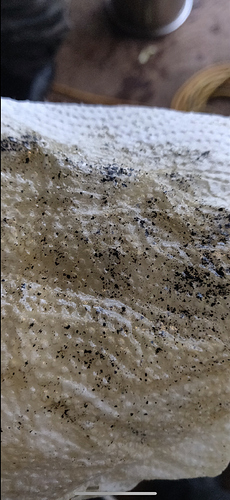Is that the boss from grandmas boy?
Possibly the tocopherols too. There’s evidence from the vegetable oil industry that they are responsible for color reversion.
Bahahaha knowledge bomb🤙
Pigment shells…if you hold them to your ear you can hear the wook waves crashing on a wook beach.
Wut??
Not my wookery, just trying to clear up some misinformation spread by a big name trying to discredit anyone using CRC while he uses it on every batch
If you look at them with an electron microscope you can actually see the topless wookets running around the beach “donating or accepting electrons”. ![]()
![]()
![]()
“Did you get into my special vapes”
10/10 would mlk
OK so no, molecules don’t really have ‘exoskeletons’, but in organic chemistry, we sometimes refer to the main core of the molecule as the ‘skeleton’ or backbone of the molecule. Bleaching is an oxidative process which essentially adds oxygen to parts of the skeleton. Often, when coloured compounds are oxidized (ie bleached), they become colourless. Meaning, bleaching clays are indeed manipulating the exoskeleton of the molecule, not removing the molecule altogether. It’s more like they’re chemically converting the pigment molecule into a different molecule that is not pigmented. So there may be some credit to this guy and his claims about T5. In order to have colour, molecules need certain properties in their ‘exoskeleton’ and bleaching clay alters the skeleton in a way that no more colour is produced. Here’s a fancier paper that is more articulate that I am:
That being said, oxidized molecules are almost always more polar than their non-oxidized analogues. They are therefore more easily retained on silica. So, if you have T5 in your process, maybe try adding a silica adsorbent downstream, and comment on the taste difference.
Hope this sheds a little light into what I think that distributor was talking about!
You are taking the bleaching too literally. We are using bleaching clays, but I dont believe we are actually bleaching in the traditional sense. In my understanding we are really only filtering out undesirables using adsorbants and only achieve a color change due to removal of those unwanted compounds. I understand what you’re getting at I just dont think it applies to CRC tech.
I agree that T5 at least mostly filters by adsorbtion. But bentonite clays have been long known to catalyze oxidation, so it’s hard to rule out. Just looking at the coin from both sides here.
Well this was one helluva rabbit hole to stick my internet nose in so early in the morning. Smells YMCA funny around here.
What’s the verdict on this olfactory burnt rubber assault? Bad gas from Cortland or shit material with a giant ratio of decarbed lipids to push through CRC filter media that furthers an already accelerated oxidation rate?
more like vagisil amirite?
Bad gas from cortland, had the same experience. Horrible horrible horrible, dumped all 3 120# tanks
We had Cortlands Gas analyzed as well as a control sample from Oxarc. I will share the results with everyone this evening. Sucks you had to dump the tanks, this happened to us recently as well and also with Cortland gas (surely they will dissapear and reappear with a new label and name soon). Sometimes its worth the extra hundo or two to know ur gas is legit. Couple bad runs and dumping gas ends up costing way way more in the long run.
very interested to hear about the oxarc test data. ive had a hunch about some bad fills from them for the past yr or so, and whatever these abnormal contaminants are, they seem to co-distill with the tane.
I would like to see that, to compare to what i was told and what i know and experienced im sure the three will be worlds apart. What kind of there gas did you test?

